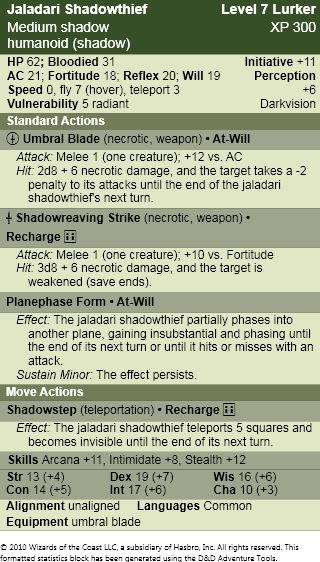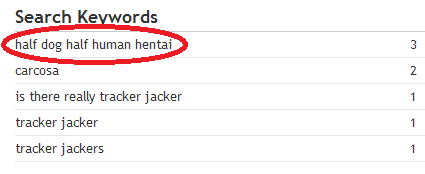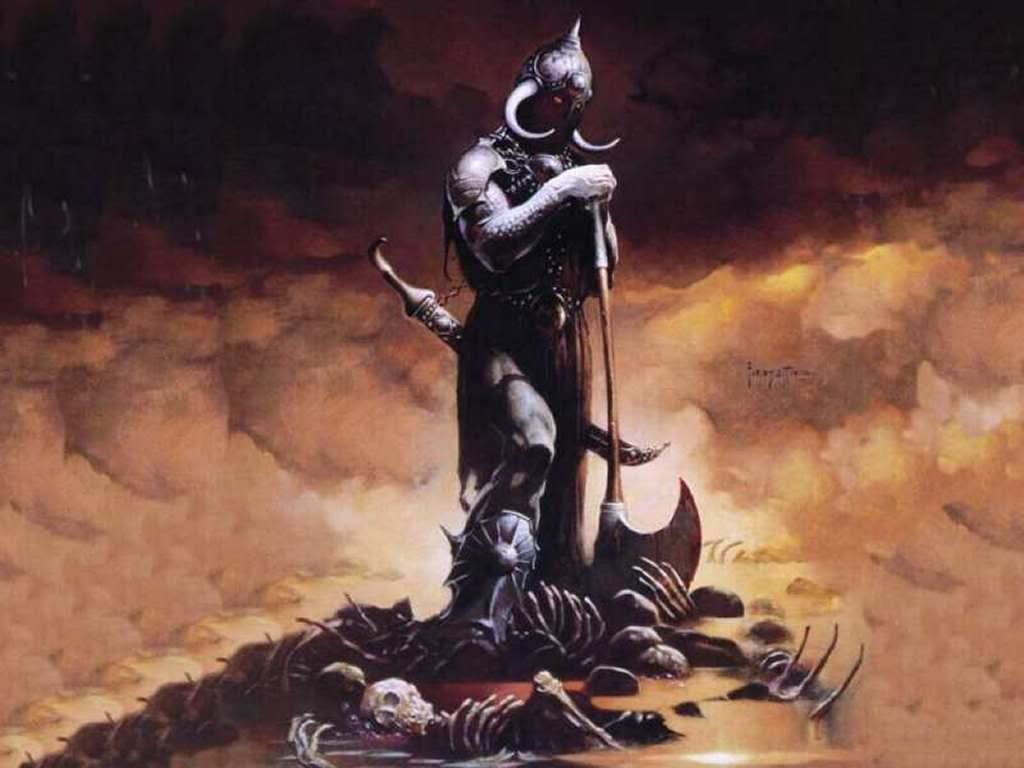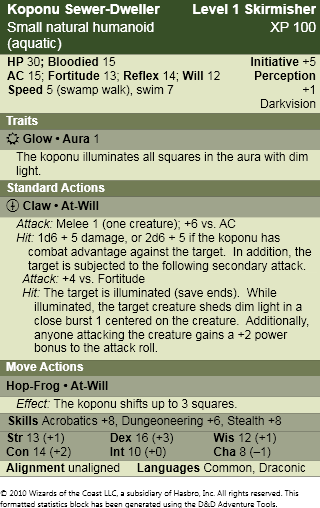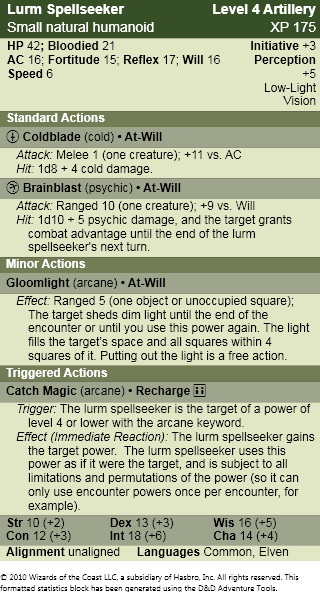So in
Crux of Eternity, I have two cities primarily run by noble families.
Sorgforge, which takes traits of
Sharn (basically enough traits for me to run
Seekers of the Ashen Crown without changing much), is run by a coalition of seven noble families in tandem with the Citadel.
And then there's
Scandshar. Scandshar is at once the most prosperous jewel and the most shameful secret of the
Sorrowfell Plains, as it is the city with the strongest economy, but it holds the seat of the area's slave trade.
Which is to say, it has any slave trade at all.
Slavery is legal in Scandshar, and you don't have to be a conspiracy wingnut to hypothesize that the mob runs everything. They
don't, but it's a pretty safe bet that they run enough.
In any case, I've been wanting to write up the thirteen noble families of Scandshar, and so I figured I'd do so here. Why? Because you might see something you like and decide to roll with it.
No more foreplay; we'll start straight away.
House Anghelescu
Colloquial Name: The Scarlet House, (vulgar) The Craven House, (temporarily) The House of Fools
Influences: Dracula.
Ravenloft.
Clan Tremere. Every creepy little horror-movie village with too much mist and
burgomasters wearing
pickelhauben. (Knowing PCs, though, if anyone ever played a character from this house, at least one person would take the Slavic aspect and run with it to play
Borat.)
Background: House Anghelescu is a rather secretive noble house. Unlike most houses, Anghelescu does very little adoption (and the old rumor is that you have to be ritually slain as part of the initiation ceremony). Strangely, those adopted by the house slowly but surely adopt some of the notable characteristics of its inhabitants, such as pale skin and red hair.
House Anghelescu is known for its pomp and circumstance, as well as a rather decadent lifestyle. In many ways, they're the quintessential stereotype of a noble house, but they keep to their duties and manage to avoid the worst of everyone's ire.
House Anghelescu is the current House of Fools, which requires them to retreat to their ward and withdraw from politics for the year.
Rumors: The most pervasive and persistent rumor — almost common knowledge, really — is that they're Vryloka. (If you haven't heard of them, Vryloka are living vampires, a recent racial addition to
D&D 4e; read more about them
here and
here.) Anybody who accepts this rumor adds a further level of speculation — how can you trust these nobles to uphold the law of the land when they owe fealty to each other and the Red Witch?
House Brissot
Colloqial Name: The House of the Righteous, (vulgar) The House of Do-Gooders
Influences: The abolitionist movement.
Dune's House Atreides.
The Wayne family.
Background: House Brissot is probably the most beloved noble house, and the one that has won the hearts and minds of the people. They are a philanthropist house, best known for charitable donations and good works. They have helped establish clerical and medical orders to keep the citizens in sound health and body. They help the impoverished. They contribute to the public welfare.
They do have one problem, though. They're staunchly — and more importantly, openly — opposed to slavery. They lobby in the Council of Lords and make public speeches about the subject. Occasionally, they purchase slaves for the express purpose of freeing them or adopting them.
This makes them popular with some, but unpopular with the other noble houses. Still, what are they going to do? Attack a fellow noble house and risk a populist uprising?
That seems about as likely as it sounds.
Rumors: House Brissot has the best reputation of the lot, but even they have whispered dealings (although supporters claim these are lies seeded by the other noble houses). Some claim that the slaves they purchase and free are never actually seen again, while those they adopt are just brainwashed slaves. Others claim that their philanthropy is a ruse, and they are secretly diabolists or necromancers or some such. Other rumors suggest the complete opposite: House Brissot hopes to overthrow the other houses and lead Scandshar into total anarchy.
House Chilikov
Colloqial Name: The House of Steel, (vulgar) The Heartless House
Influences: Soviet propaganda.
Metropolis. Anything with cool robots, really.
Background: The Chilikov weren't always
Warforged. Once upon a time, they were a warlike house of humans, dwarves, and the like, poised to overcome obstacles with military might. The family was already dwindling by the time of the Cackledread War — most people think good, old-fashioned fertility problems were to blame — but they contributed soldiers and their own Warforged to the war effort.
At the end, only the patriarch, an old dwarven artificer by the name of Stalbek, remained. Tired of the politics and intrigues of the noble houses, Stalbek retired, leaving the Warforged in charge. He left for parts unknown, likely in the Hoarfrost Mountains.
These days, the Warforged help carry out the industrial functions of the city. Nobody has ever had trouble with House Chilikov, and indeed, they are considered the least duplicitous of the noble houses. They also don't typically hold slaves, as they apparently do not understand why anyone would use reluctant workers to do important tasks.
Astute observers note that they do not oppose slavery; they simply do not understand how it is efficient.
Rumors: Common rumor suggests that old man Stalbek still controls the house from behind the scenes. He either went into hiding so he could remove himself as a target for his enemies, or to add a level of deniability between himself and his plots. After all, if his patsies don't comprehend his plans, the nobody can interrogate them.
House Claasen
Colloquial Name: The House of Fate, (vulgar) The House of the Doomed
Influences: Dark Shadows. Every creepy, New England family from
H. P. Lovecraft.
Background: Despite the name, Fate is rarely kind to House Claasen. They are an ancient family, possibly the oldest in Scandshar (if true, they may very well be the founders of the city). They control the shipping lanes, and so have an important role in the Scandshar's commerce.
And yet, many strange things are said about House Claasen. Some claim there are family members too deformed to see daylight, or that there are secret and ancient rituals that take place in the depths of their estates. Some claim the elders are no longer human; some even say that the original bloodline founders are still around, either existing as undead, or undying sorcerers, or disembodied spirits, or an amalgam of grey matter not unlike an
illithid Elder Brain.
Who knows, really? Like many of the families, the Claasen are quite secretive.
Rumors: Rumors are rampant that House Claasen labors under some ancient curse — maybe from the land, maybe from the stars, or possibly even from the first slaves who lost their freedom in Scandshar. It would certainly explain a lot of things while raising further questions.
House de Rais
Colloqial Name: The House of Velvet, (vulgar) The House of Killers
Influences: Hunter: the Vigil's
Ashwood Abbey.
Gilles de Rais.
The Most Dangerous Game.
Background: House de Rais is considered the most decadent of the houses. They are known for wild orgies, insane parties, and eccentric behavior that leaves them the talk of upper class salons and low class taverns throughout Scandshar.
House de Rais is particularly feared by the citizens due to the rumors surrounding them — known to be incredibly jaded, House de Rais engages in increasingly twisted pleasures to amuse themselves. Rumors suggest that they will hunt their own slaves or even strangers off the street, staging bloody contests in the darkened alleyways of Scanshar, or the countryside beyond the city walls. Some even suggest that they are diabolists and steal human sacrifices by night.
The city always seems to breathe a little easier when House de Rais is nominated for the House of Fools, as the night seems just a little safer without the House of Killers on the prowl.
Rumors: House de Rais is primarily known by its rumors, as there is precious little evidence to suggest they are anything other than cynical pleasure-seekers. Still, the rumors continue to fly, and the occasional mutilated body is found in the vicinity of their Ward. One of the most striking rumors is that they perform these ghastly rites not out of ennui or devil worship, but because they are desperately trying to keep something locked away. Similarly, some say that they cultivate the rumors themselves so as to hide a true agenda.
House Ehrenfest
Colloquial Name: The Inspired House, (vulgar) The House of Torturers
Influences: Frankenstein.
Professor Hubert J. Farnsworth.
Steampunk. Mad scientists of all stripes.
Background: House Ehrenfest is continuously engaged in scholarly research, but unlike Gorupa, Helltalon, or Silversgleaming, they're all about field testing and experimentation. A collection of Artificers, builders,
Grease Monkeys, magicians, and tinkerers, House Ehrenfest aids the town's commerce through constant innovation. They build the blueprints of Scandshar's future infrastructure, they develop new magic items and new technologies, and they keep Scandshar the shining jewel of the Sorrowfell Plains.
Of course, the price of genius carries its own set of challenges. This isn't true across the board, but the constant pressure to study and compete leaves precious little time for the Ehrenfest to socialize. A notable number of Ehrenfest probably rank on the modern
autism spectrum. And some members have trouble understanding why others find their experiments — such as dabbling in necromancy — distasteful.
There's a persistent claim that Ehrenfest maintains its own calendar, which they call the Circle. Unlike the
Dozenmonth, the Circle follows mathematical principles rather than astrological ones.
Rumors: The annals of history are rife with Ehrenfest dealing in the black arts, and at least one lich haunts the family tree. Additionally, persistent rumors suggest that some Ehrenfest will subject their slaves to horrid experiments, or kidnap people off the street. It is also worth noting that while they may not be the most sociable sorts, they are still masterminds of ruthless intrigues.
House Gorupa
Colloquial Name: The House of the Dead, (vulgar) The House of Liches
Influences: A hodgepodge of
Shaiva rites,
Thuggee cults, and
death rituals from all over.
Background: Nobody knows when the changeover happened, but at some point, House Gorupa went from death cultists to being dead. Revenants occur when a sapient being swears fealty to the Raven Queen, goddess of death, upon its death. They reincarnate as pale humanoids with minimal memories of their previous incarnation, and they go about their business. Like
mythological revenants, they have some sort of agenda, although this typically comes from the Raven Queen (although not always — some Revenants owe fealty to whatever force raised them while others owe fealty to no one).
House Gorupa continues with the same intrigues as the rest of the noble houses, but they practice private death rites. Back in the Cackledread War, when House Marantu's ward was razed by marauding gnolls, House Gorupa immediately abandoned their ward to live in the ruins. They still live in the slums, occupying the rotting graveyard of Scandshar, plotting deathless plots.
Rumors: An entire noble house that theoretically pledges fealty to the goddess of death? That's hardly disconcerting at all.
House Helltalon
Colloqial Name: The House of Penitence, (vulgar) The Damned House
Influences: D&D 4e's
Bael Turath.
Hunter: the Vigil's
Lucifuge. The typical penitent sinner schtick.
Background: Despite the fearsome name, House Helltalon is generally well-regarded among Scandshar's natives, although they are not entirely trusted.
Because they're all tieflings, of course.
House Helltalon is apparently an offshoot of some noble house in old Bael Turath. After the fall of the Turathi empire, they scattered, finally settling in Scandshar. Many think they may be the wealthiest of noble houses, having built their wealth atop anything they retained from the old empire.
House Helltalon helps bankroll Scandshar's libraries, as well as the temples in the Temphill district. With the aid of House Brissot, they keep the city's citizens fed and healthy. They still practice slavery, but their slaves are typically among the best-treated slaves of the lot, and are practically considered members of the family.
Strangely, those who are adopted into the house are typically found to have infernal blood somewhere in the family tree. Indeed, many such prospective family members bear strange birthmarks or deformities (like tieflings prior to 4e). Typically, they can easily interbreed with tieflings and tend to "breed true" in a generation or so.
Rumors: Isn't it obvious? There are pretty long-standing claims of diabolism and demonology amongst the scholars and ascetics of House Helltalon. Some claim that the slaves are well-treated only because they are brainwashed, or because mistreated slaves are never seen. Others claim that House Helltalon is deliberately seeking to adopt those with infernal blood, so as to strengthen their lineages. One rumor notes that
Duchy Jepson was built on known ruins of the dragonborn's Arkhosian Empire, and suggests that Helltalon deliberately came to the Sorrowfell Plains to pilfer the ruins. Secret archaeological expeditions supposedly occur so that the Damned House can torture the ancient dragonborn souls of Arkhosia beyond the veil of death itself.
House Kardec
Colloquial Name: The Illuminated House, (vulgar) The Slumbering House
Influences: Doctor Manhattan.
The Brotherhood of Mutants.
The eugenics movement. Probably more than a little
House Harkonnen.
Background: House Kardec values the perfection of the self. For quite some time, House Kardec has trained its adepts in psionic powers, suggesting the members of the house perfect body and mind. Exercise,
biofeedback, and psychic mastery are all drilled into all young Kardecs.
Apart from giving House Kardec an ego that rivals House Silversgleaming, House Kardec does maintain a psychic academy as well as gymnasia and all manner of similar things. They try to be movers and shakers, a part of the world but apart from it.
House Kardec adopts the fewest new members of any other house, primarily because they wish to maintain their psychic supremacy. Inbreeding is rampant among the family, although they try to intermarry distantly whenever possible. They typically only adopt those displaying psychic talent; it is suggested that they pay families who add new blood to House Kardec, leading many desperate families to present their children for testing.
Strangely, many members of House Kardec appear almost as perfected specimens of their respective races. Scholars in the know suspect that Kardec has obtained a copy of the rite of Awakening and are forming their own cadre of Elan. (The Awakening and the Elan are described in
D&D 4e's
Psionic Power, pg. 124-126 and 142-144, among other sources. Those without the book should check out
their entry on the d20srd.org as well as
their entry on the D&D Wiki, both of which describe their 3e incarnations. Note that the elan are not born; they are deliberately made through the rite of Awakening.)
Rumors: House Kardec is so arrogant and separated from their humanity that its members barely recognize sapient life anymore. The whispered claim is that they are decadent and cruel partially from ennui and partially because they are turning into
something other than human or demihuman. Some also whisper that the high number of Elan in their midst is tainted by a similarly high number of Foulborn (that is, people with Far Realm taint in their blood).
House MacBeth
Colloquial Name: The House of Silence, (vulgar) The House of Blood
Influences: The Tragedy of Macbeth.
The Godfather.
The Sopranos.
General Hospital.
Background: House MacBeth doesn't have the mortuary duties of House Gorupa, but they perform a lot of other tasks regarding infrastructure and sanitation. The other houses sometimes look down on them, although it is typically tongue-in-cheek — it does not do to offend the nobles of House MacBeth.
Why?
Funny story, that. Bad things happen to House MacBeth's enemies. People tend to suffer accidents, or go missing.
See, it's a pretty open secret that House MacBeth has
their own thing happening, and that they are more than capable of keeping it together. Of the other noble houses, they are the most likely to adopt, but those who are adopted are typically drawn into MacBeth's rackets.
Rumors: House MacBeth always has some pretty wild rumors — if a prominent citizen leaves town for more than a fortnight, some wag always says that MacBeth whacked him — but the whole "organized crime syndicate" thing is pretty much an open secret. The most prevalent rumor these days is that
the Illustrious Menagerie of Peacocks would not leave a rival alone, and that they probably oversee all of House MacBeth's rackets.
House Silversgleaming
Colloquial Name: The House of Enchantment, (vulgar) The House of Arrogance
Influences: High elves everywhere.
Beauxbatons.
Background: House Silverslgeaming is better than you.
No, seriously. House Silversgleaming is composed primarily of
eladrin (that's
D&D 4e high elves, not the celestial beings of 2e and 3e), and it shows. They are true heirs to the aristocracy, and are more likely to spend their leisure time practicing magic, swordplay, or some other art rather than engaging in debauchery.
Although they manage to do plenty of that, too.
House Silversgleaming typically only adopts members of other fey races, such as elves, gnomes, and so forth. They are known to particularly look down upon House Zantaal (for being monsters) and House Weogora (for being
nouveau riche). The long average lifespan of the family gives them a different perspective on events — their plans are more intricate, but take longer to reach fruition. It doesn't bother them that they are the House of Fools for an entire year, but that they are the House of Fools every thirteen years — it is frequent enough to the fey mind to be
quite annoying.
Rumors: House Silversgleaming has the typical diabolist/demonologist rumor that tends to follow families with an arcane bent. Some also claim that they're attempting to enact a grand ritual to shake the nature of the planes. Others claim that they have a
Ring of Three Wishes — one of the few left, certainly — which they hold as a trump card. One particularly odd rumor is that they are all secretly
Gruumsh cultists.
House Weogora
Colloquial Name: The Novel House, (vulgar) The House of Children
Influences: Nouveau riche. Anything written by
P. G. Wodehouse.
Background: The founders of House Weogora are all foreigners, being Nerathi officers shipped to the Sorrowfell Plains as part of the war effort during the Cackledread War. When the war ended, many of these officers were left in a very odd position — the military campaigns in the Sorrowfell were very successful, but Nerath still lost the war. There were no accolades from the Emperor, and no home to which they could return.
Fast forward a couple of years. These veterans typically had a little bit of coin from the war, and they supplemented their income with dungeon delves and the various odd jobs the Sorrowfell needed in the aftermath. Since House Marantu was destroyed during the war, and House Gorupa abandoned their ward to live in the ruins, there was an open position in Scandshar's Chamber of Lords.
House Weogora filled that position.
In the roughly fifty years since, the uncouth veterans of the Cackledread War raised their heirs to be
genteel aristocrats. They're still seen as arrogant bumblers and upstarts by the other noble families of the city, but nobody can deny that their aid helped Scandshar's recovery after the war.
They aren't as decadent as some of the noble families, but they do have a reputation as layabouts and
Hooray Henrys for a reason.
Rumors: Oddly, House Weogora triggers some of the worst rumors of the lot — people either say nasty things because of their low-born origins, or they assume a hidden agenda. House Weogora is putting up an act; they're either
Moriarty or
the Scarlet Pimpernel. All members of House Weogora are kidney-eating diabolists. House Weogora secretly controls the other houses.
House Zantaal
Colloquial Name: The Primal House, (vulgar) The House of Monsters
Influences: Sword-and-sorcery without the humanocentric trappings. Think of bugbears and hobgoblins acting as characters from
Kull or
Conan or
He-Man or
John Carter and you'll be okay.
Background: The Zantaal are a noble house containing what is sometimes called the "
monstrous humanoids." They still retain ties to their savage roots — they are among the most notable practitioners of primal magic in the city and possibly in the region (that last is a pretty tall order, but you have to sell yourself, right?) — but they stand in Parliament and debate with the best of them. Nobody's really sure if being the embodiment of primal, humanoid hindbrain fears is a boon or bane to their ambitions, but then again, you try figuring that out when a
mongrelman is shouting at you about
tort reform.
Not so easy, is it?
Rumors: According to rumor, the Zantaal plan on overthrowing humanoid rule in Scandshar, establishing the goblinoids, orcs, and suchlike as the dominant races. Some truly paranoid types offer one obvious piece of evidence: how often do you see goblin or orc slaves versus human or elf slaves? (Some people quietly suggest "market pressure," because what rich guy wants to get served by a hulking bugbear over a graceful elf?)
